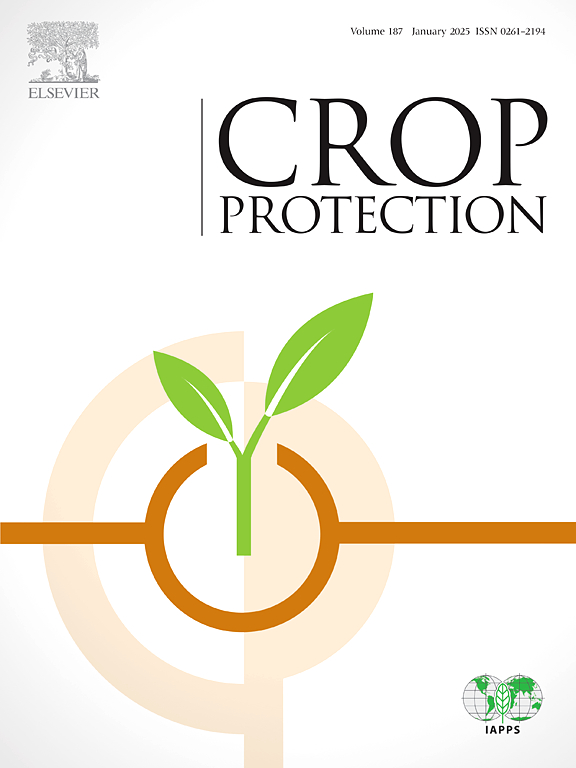乳黄小蜂饵料对第三营养级拟寄主小蜂适合度的影响(膜翅目:小蜂科)
IF 2.5
2区 农林科学
Q1 AGRONOMY
引用次数: 0
摘要
在植物-植食昆虫-天敌的三级营养结构中,植物对天敌有直接和间接的作用。此外,寄主对天敌的食性影响也对害虫防治产生间接影响。本文采用年龄分期、两性寿命表分析法,研究了两种饲料对艾弗estia elutella天敌habrobron hebetor适合度的影响。结果表明:饲喂人工饲料的乳臭虫第0代的总产卵量、产卵日数、产卵日数和雌虫寿命显著高于饲喂烟叶的乳臭虫。寄生在人工饲粮上的褐家鼠F1代成虫前成虫存活率、麻痹率和寄生率均显著高于采食烟叶的褐家鼠。该研究结果为在实验室中大规模繁殖和提高烟仓内黑僵菌的防治效率提供了理论依据。本文章由计算机程序翻译,如有差异,请以英文原文为准。
Effect of Ephestia elutella diets on fitness of the third trophic level, the parasitoid Habrobracon hebetor (Hymenoptera: Braconidae)
In the three-level nutritional structure of plant–phytophagous insect–natural enemies, plants exert direct and indirect effects on natural enemies. Additionally, the effect of the host diet on natural enemies also has an indirect impact on pest control. Herein, the effects of two diets of Ephestia elutella on the fitness of its natural enemy Habrobracon hebetor were studied using an age–stage, two-sex life table analysis. The results indicated that the total fecundity, the number of eggs laid during each oviposition day (Ed ), oviposition days, and female longevity of the H. hebetor of F0 generation parasitized on E. elutella fed an artificial diet were significantly higher than those on E. elutella fed tobacco leaves. The pre-adult survival, paralysis, and parasitism rates of the H. hebetor F1 generation parasitized on E. elutella fed an artificial diet were also significantly higher than those on E. elutella fed tobacco leaves. The results provide a theoretical basis for the large-scale propagation of H. hebetor in the laboratory and for improving the efficiency of H. hebetor in controlling E. elutella in tobacco warehouses.
求助全文
通过发布文献求助,成功后即可免费获取论文全文。
去求助
来源期刊

Crop Protection
农林科学-农艺学
CiteScore
6.10
自引率
3.60%
发文量
200
审稿时长
29 days
期刊介绍:
The Editors of Crop Protection especially welcome papers describing an interdisciplinary approach showing how different control strategies can be integrated into practical pest management programs, covering high and low input agricultural systems worldwide. Crop Protection particularly emphasizes the practical aspects of control in the field and for protected crops, and includes work which may lead in the near future to more effective control. The journal does not duplicate the many existing excellent biological science journals, which deal mainly with the more fundamental aspects of plant pathology, applied zoology and weed science. Crop Protection covers all practical aspects of pest, disease and weed control, including the following topics:
-Abiotic damage-
Agronomic control methods-
Assessment of pest and disease damage-
Molecular methods for the detection and assessment of pests and diseases-
Biological control-
Biorational pesticides-
Control of animal pests of world crops-
Control of diseases of crop plants caused by microorganisms-
Control of weeds and integrated management-
Economic considerations-
Effects of plant growth regulators-
Environmental benefits of reduced pesticide use-
Environmental effects of pesticides-
Epidemiology of pests and diseases in relation to control-
GM Crops, and genetic engineering applications-
Importance and control of postharvest crop losses-
Integrated control-
Interrelationships and compatibility among different control strategies-
Invasive species as they relate to implications for crop protection-
Pesticide application methods-
Pest management-
Phytobiomes for pest and disease control-
Resistance management-
Sampling and monitoring schemes for diseases, nematodes, pests and weeds.
 求助内容:
求助内容: 应助结果提醒方式:
应助结果提醒方式:


